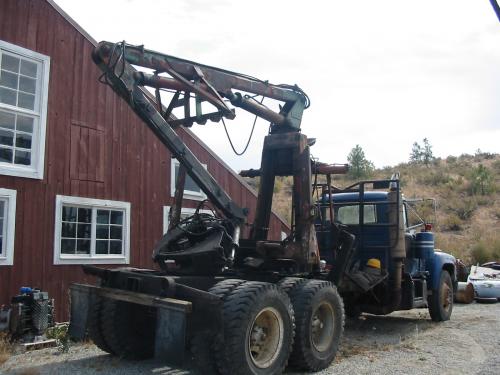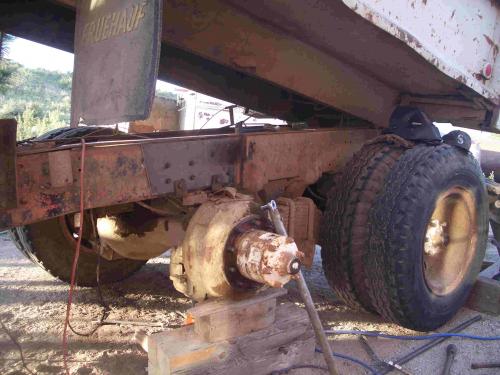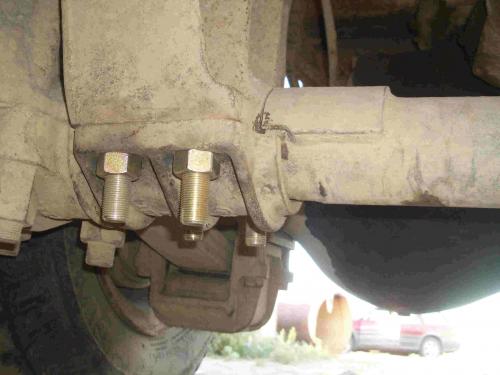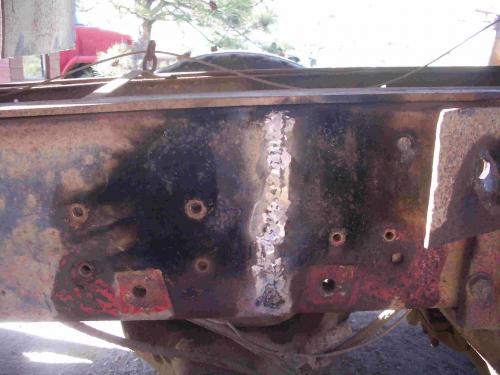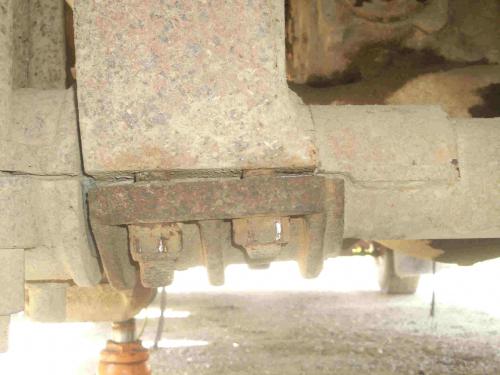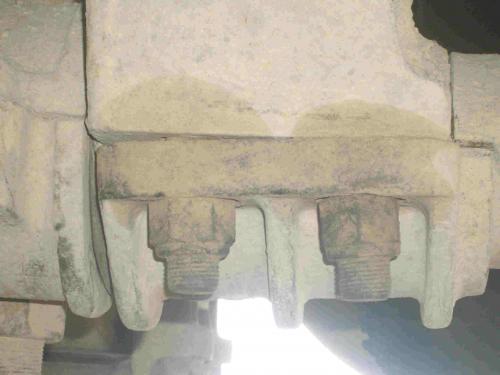
martinf
Puppy Poster-
Posts
47 -
Joined
-
Last visited
Content Type
Profiles
Forums
Gallery
Events
Blogs
BMT Wiki
Collections
Store
Everything posted by martinf
-
Where To Go From Here
martinf replied to martinf's topic in Antique and Classic Mack Trucks General Discussion
It seems to run pretty darn well with no missing. I'll start with a compression test. How would I know if there's a dripping injector? ah, the log loader. One ofthe reasons I bought the truck. The loader IS coming off, but only because it's going on my sea mule tug boat that I am restoring. And then this Mack will be used to haul the boat in and out of the water. Though, since the boat is 60,000 lbs, that won't happen all that often! Check out www.seamule.blogspot.com -
Hi all, I don't know if you remember me, but I am the guy who posted pictures and story of popping a wheelie in my '65 b75. Well, I've now got a 74 R series with a log self-loader that has got some engine troubles. It's got a Cummins in it and it smokes a lot. The smoke doesn't go away after extensive warm up. Black on acceleration and then lots of whiteish blue and smells like diesel. SO, that made me suspect a wet cylinder. I took temp readings of all 6 and the back one is a full 100 degrees cooler than the rest. Seems like the likely problem. Where do I go from here?
-
Welding Frame Controversy
martinf replied to martinf's topic in Antique and Classic Mack Trucks General Discussion
Well, I got the frame repair done. Welded the crack (7018, after grinding out and pre-heating) then ground flat and botled on a reinforcing plate 1/4" by 9 1/2" wide by 24" long (angled sides). For thru bolts, I used some exsisting open bolt holes. I didn't like the fact that they were in straight lines, but the holes were already there which seemed to trump the "no straight line" rule. Also, the holes went thru exsisting frame support members, like cross frame etc. and that seemed especially a good idea. I had to drill a few more, too. I used 1/2" flanged frame bolts. Turned out pretty darn good and I don't think I'll have to worry about this frame. In this pic, there's still another bolt to do up towards the top on the left side. Thanks for all the assistance. I learned a bunch about frame repair from you guys. ~martin Also got new trunnion cap bolts on. The caps were so loose, you could turn most the bolts by hand! -
Welding Frame Controversy
martinf replied to martinf's topic in Antique and Classic Mack Trucks General Discussion
SInce you asked... Here's how it's going I've got the crack welded up with 7018 after grnding out and pre-heating. Went okay, though I'll admit that vertical welding is not my specialty. I got all the bolts off so there's plenty of real estate for a reinforcing plate. In fact, there's already quite a few holes in there frame that I can use by drilling matching holes in the reinforcing plate and using longer (and higher grade) bolts in the original holes. A couple of questions: On the inside of the frame rail towards the front of the crack (the crack is exactly above the overspring pad), there was already a big reinforcing plate boltied thru (see the front four holes in the pic). This is factory done, correct? I'm thinking to put in a reinforcing plate as tall as the frame and 20" long (say 10" each side of the crack). I can't go any farther back than the trunion pedastal bracket, but I can use all the exsisting thru holes to help bolth this thing in. My other question concerns the top of the frame. Should I bend the reinforcing plate up and ontop of the frame rail? I could cut out a section of that 1/4" x 3" steel that lying on top of the frame. And, if I were to do that, how would I attach it on the top? If I flange bolted it, the bolt heads would protrude and mess with the dump bed. I suppose I could countersink the bolts or how about welding a lap seam up there on the inner edge of the frame rail C channel? Or for that matter--and I promise this is the last question--how about just welding that exsisting 1/4" x 3 steel flat thats lying on top of the frame rail? WHat is that piece of just tacked on steel for? To keep the dump bed from rubbing the frame? (I guess that was one more question). Hey, I really appreciate you guys taking the time to answer my newbie questions. This site is really great and you all have been really good to me. thanks, ~martin -
Great, thanks, that's what I'll do. Any thoughts as to how they got so loose? ~martin
-
quote name='MACKS' date='May 17 2009, 06:50 AM' post='35305'] Rob, he is talking about the trunion caps,the two caps that have four bolts in each witch hold the trunion stands to the bar.I never used a torque wrench on them I just tighten them equally with a big air gun,you want the cap to go on straight so tighten each bolt a little at a time. That's it! Okay, so before I replace bolts, I'd like to understand a bit about what's going on here.... The caps are downright loose. well, I can't shake them, but the bolts can be spun in the holes by hand. So how did the caps and bolts get so loose? And why is the opening between cap and trunion stands much bigger on the wheel sides than on the insides? Did something bad happen or is this normal for an old truck? And then regarding the fix. Since this truck is only used to haul stuff up on my ranch (not even licensed for the road), could I get by with just tightening up the bolts? And, since I'll need to use heat to persuade them, will that weaken them even more? (this sounds like a bad idea even as I write it!) And, if I could ask one more question, what's the proceedure here? It looks like I could take off all four bolts, drop the cap, wire brush clean/ weld beads if need be to tighten the slop up, put new bolts in and re-tighten. I'm assuming the trunion cross tube will stay put as long as the spring assemblies are all in place. thanks again[
-
Rob, thanks, and what is the official name for the thing I am calling a "cap"?
-
Thanks for the info guys. And what should I torque those trunion cap bolts to? ~martin
-
Bear with me on the lack of correct terms here... I've got a 1965 B set up as a dump truck with bogie camelbacks. The caps that hold the trunion tube to the trunion stands( or do you call it supports?) have 4 bolts on each side of the truck...and they are marginally loose. One even has the head popped off. There's even some space between these bottom caps and the tops. Just to clarify here, I'm not tallking about the ubolts at the spring pads/perches. A couple of questions for you expert wrench spinners.... Should I tighten or replace these bolts and nuts? They're pretty rusty and funky. What grade should I replace with? Could someone explain to me the function of these things that I am calling caps? Seems like they hold the trunion tube up against the stands. SInce the wieght of the truck bears down on the trunion stands and onto the tube, it seems like these only serve as to hold the trunion in place (and deal with the bouncing up of the suspension system when you went over a bump, for example. Is this correct? Thanks for bearing with my lack of correct terms and for helping me understand what purpose these serve and how to fix. ~martin
-
Welding Frame Controversy
martinf replied to martinf's topic in Antique and Classic Mack Trucks General Discussion
Hey everybody, Thanks for all the great advice. I'll take it! and weld the crack and bolt a fish plate with grade 10 flange bolts. It's my own dang fault this happened in the first place. As some of you amy remember, this truck was the one I popped a serious wheelie in last year when I was trying to haul a 10 ton 20 ft long barge section up a gravel mtn road. WHen I popped the wheelie I also cracked the frame. Live and learn. ~martin -
Hey all, I got a '65 B set up as a dump truck. I cracked the frame rail all the way top to bottom (can you say too heavy of a load?!) So, I was planning on grinding out the crack, welding that up, grinding flush and putting a big fish plate reinforcer on and welding it up good with 7018. Then I happened to see in the maintainence manual "Hints about frame repair." They enocurage welding cracks, but strongly say to NOT weld reinforcing plates, but instead bolt them in. Hmmn, why would you weld the crack but then not be able to weld plates? I know about stress cracks and what all, but I thought that the fish plate appraoch eleviated that a lot. And then searching on this site, I see differing opinions about welding or bolting frames. At the rish of stirring this old controvery up again, I'd like to hear some more opinions about this.... thanks, ~martin
-
I've got a NTC-335 cummins in my R 763 and I need to dump the coolant for the winter. I opened the petcock in the el on the bottom radiator hose, but seems like there must be a plug or two on the block or water pump? I don't have a manual for this one so I'd rather be safe than sorry. Any other places I need to open it up to drain? thanks for any help. ~martin
-
SO, besides having two Macks, a B and a R, I also have an old WWII tugboat I am restoring. But, first I seperated it in to 4 sections and was hauling them up my road (1 mile long, 16% grade and 5 switchbacks) in the back of my Mack B dump. Well, as they say, a picture's worth a 1,000 words.... http://forum.hcea.net/viewtopic.php?f=3&am...c44f45756e779e7 glad you can laugh at my expense! ~martin
-
Hey all, Anyone knowwhereI can pick up a engine manual for the NTC-335 cummins I've got in my R 763? I see a lot of cummins manuals on Ebay, but not any for the NTC-335 engine. Are there other engine series manuals that would be similar enough to be useful? thanks for any help. ~martin
-
I've got a R763 with the cummins 335 in it. I haven't had this truck long, but man it smokes. Lots. WHitish gray. Huge amounts on start-up and then even after it's warmed up. It's an old logging truck with a prentice self-loader on it and I really bought it for the loader, but would like to fix the truck up. I don't know this engine well enough to know what to suspect. Also, anyone know where i can pick up an engine manual for the NTC-335 cummins? I see lots on ebay, but not for the 335. Would other NTC series be close enough that those manuals would be useful? thanks for any assistance. ~martin
-
James, Got it all hooked up and the brake adjusters set and I'm good to go. Loosing some air pressure somewhere, gotta track that one down next. thansk for the assistance. ~martin
-
That makes sense. It'll be a week or so until I've got some time to investigate all this. Thanks for the phone help offer, James, I'll take you up on it if I need it and will report back later. ~martin
-
SO, since the parking brakes are released by air pressure, I should have a source of air coming out of one of the supply pipes (the one other than the brake source that supplies air when I hit the brake shuttle) all the time the truck is running, correct? I don't have any air coming and that's what I am wondering about. Ideas? ~martin
-
Hey All, I've recently got a 1971 MAck R series truck, set up for logging with a self-loader. The hydraulic grapple had busted off the air brake line Tees at the rear axle. WHen I got it, things were pretty messed up and disconnected. SO here's my questions: Which chamber does the air brakes line connect to? I know there's a spring brake chamber and the air brake chamber, but I don't know which air fittings is for which. Do the air brakes connect to the front (smaller) chamber and the spring brake is the larger (rear) chamber? Also, I'm assuming that the air supply line to the spring bake chamber is supposed to be ON as long as the truck is running. Ther eare two suppluy lines coming back there. One is on when I press the brakes, the brake line, of course. But the other one is not ON when the truck is fired up. Am I missing something here? Like a switch up front I must first engage. Obviously, I'm showing you all that this is my first MAck truck! ANy help with this would be greatly appreciated. btw, I know all about the dangers of opning up the spring brake. thanks, ~martin
-
So, I've now got my first Mack truck, and must admit Idon't know the first thing about them. This one is a 1971 set up as a logging truck with a Prentice self-loader. For starters, I'd like some help identifying the model, etc. On the door frame was R763S and a serial number of 1574. Is that enough for soemone out there to tell me a bit about my truck...what model etc? And if you could steer my in the right direction as to where I might get some manuals for this truck, I'd be obliged. thanks, ~martin
-
I bought a 1971 Mack Truck last week that will be towed home next week. It has a severed back air line. It's got a Prentice self-loader (with a hydraulic grapple) and a 350 cummins. It all runs and I watched the loader pick up a cadillac scrap car in the junk yard. 2500 bucks. Seemed like a good deal. That's about all I know about this truck. I must admit, this will be my first "big" truck, but I do have lots of construction equipment, graders, cranes, dozers, etc. so I'm not new to the area. Being a real Mack novice (I don't even know what model this thing is) what would you recommend to begin getting my feet wet? thanks, ~martin
BigMackTrucks.com
BigMackTrucks.com is a support forum for antique, classic and modern Mack Trucks! The forum is owned and maintained by Watt's Truck Center, Inc. an independent, full service Mack dealer. The forums are not affiliated with Mack Trucks, Inc.
Our Vendors and Advertisers
Thank you for your support!


